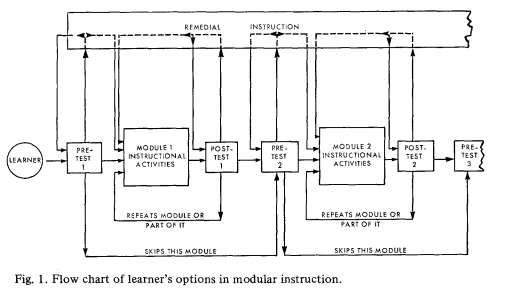PERHATIAN KEPADA PELAJAR, Sila pastikan anda telah melaksanakan Proses Pengurangan Storan M365 anda. Kegagalan melaksanakan proses tersebut mengakibatkan AKAUN ANDA AKAN DIBEKUKAN.
Akaun identiti yang dibekukan tidak boleh menggunakan perkhidmatan Pearl@USM, Wifi, CampusOnline, M365 dan perkhidmatan yang menggunakan Single Sign On.
Sila pastikan saiz used di Mailbox dan OneDrive anda perlu kurang dari 1GB.
Untuk menyemak saiz storan anda sila rujuk kepada pautan berikut:
Sila rujuk pautan berikut untuk maklumat lanjut:
Jika terdapat sebarang pertanyaan, sila hubungi Servisdesk PPKT di talian 04-653 4400.
Sekian, untuk perhatian dan tindakan segera anda.
Terima kasih.
Please ensure the size of the used space in your Mailbox and OneDrive is less than 1GB.
To check your storage size, please refer to the following link:
Please refer to the following link for more information:
If you have any questions, please contact the PPKT Service Desk at 04-653 4400.
Thank you for your attention and prompt action.
Best regards,
Principles in Distance Learning
1.Go through the learning material
Make sure you’ve reviewed all the content provided. This will give you a solid foundation about ODL and SIM.
2.Complete the learning activity
Engage with activities first. These are designed to help you relate what you've learned.
3.Complete the self assessment
Engage with the self-assessment by answering all the questions. You can click export button to save your answers and make it as a note.
This is a learning activity. If you are at this step, you should have completed reading all the learning materials.
Activity: Instructor roles
Principles in Distance Learning
As you know Open Distance Learning (ODL) has come a long way, especially in recent years, thanks to the power of technology. It's amazing how much the landscape of education has changed, especially since COVID-19. The pandemic really pushed educational institutions to rethink how they deliver learning, and technology became the major role of the story.
ODL was already a great option for people who couldn’t attend traditional classes—whether because of where they live, their work schedules, or other commitments. Think about it, with high-speed internet, smartphones, and cloud-based learning platforms, students can now access their lessons from virtually anywhere, at any time!
What’s really exciting is how technology has made ODL more engaging and interactive. We’ve got virtual classrooms (PEARL portal), video conferencing (webex), educational applications and even gamified learning experiences that make studying from home feel a lot more connected and dynamic.As digital tools continue to evolve, ODL will likely play an even more significant role in shaping the future of education
In SDE, we have 74 academic staffs from diverse fields, 39 administrative staffs including officers and Deputy Registrar. Our enrolment of students are ±4,500 (based on Dec 2023). SDE also have over 20,000 graduates from each of 4 programmes mentioned above.
Did you know that SDE is a true pioneer in Open Distance Learning (ODL) programs since 1971? In fact, it holds the distinction of being the longest-running ODL initiative in any Higher Education Institution in Malaysia. Impressive, isn’t it? 😃
SDE’s journey began over five decades ago when it recognized the need to provide flexible learning opportunities to those who couldn’t pursue traditional, on-campus education. Since its inception, SDE has been at the forefront of delivering quality education, adapting to changing educational trends and technological advancements. Now, let's take a look of the journey of SDE since 1971 (from left to right)

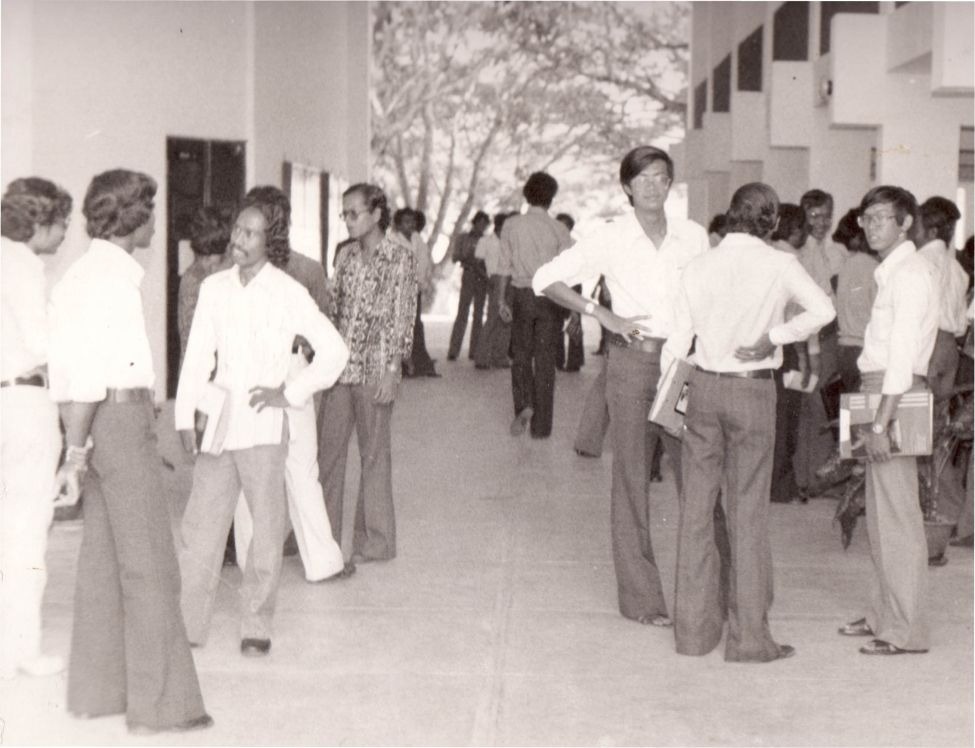
The Off-Campus Programme was upgraded to Off-Campus Studies Unit.

The Off-Campus Studies Unit was further upgraded to Centre for Off Campus Studies and moved to the Long House as its temporary building.
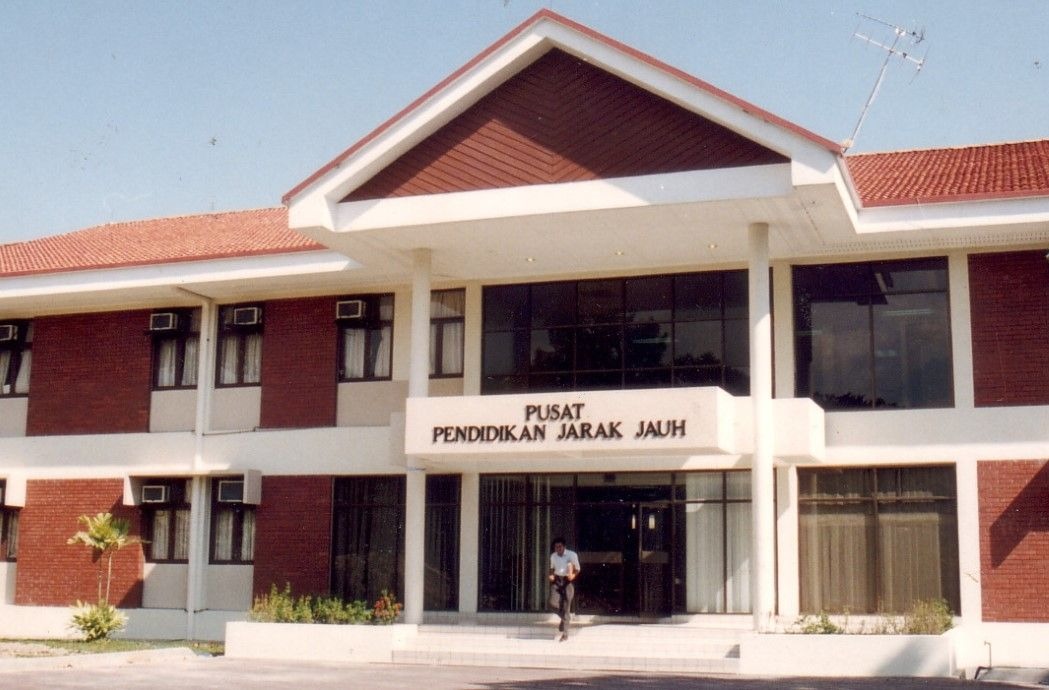
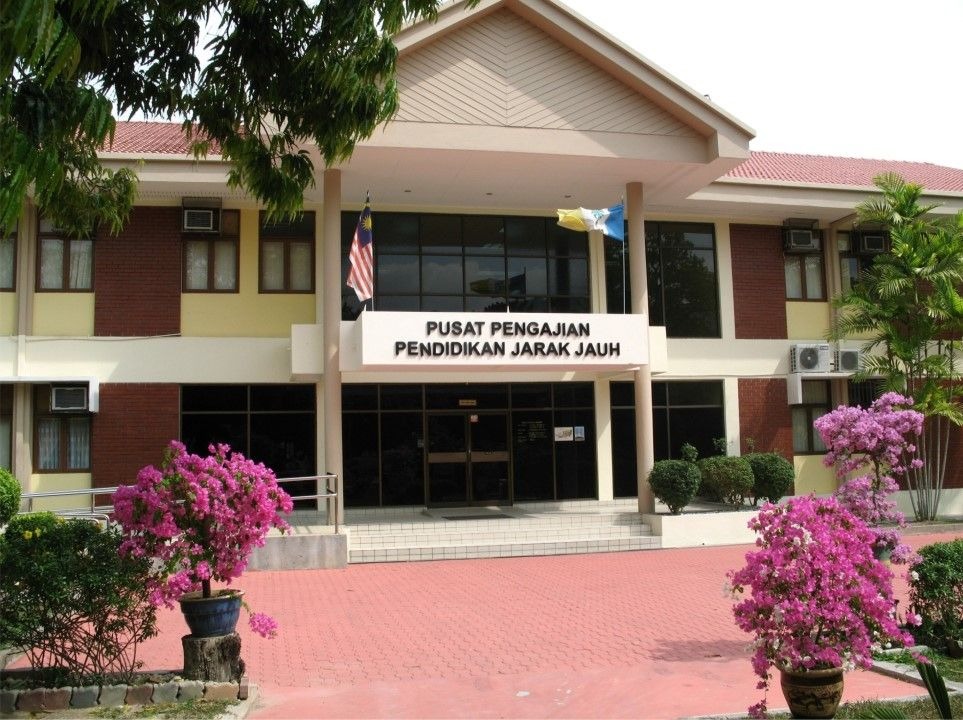

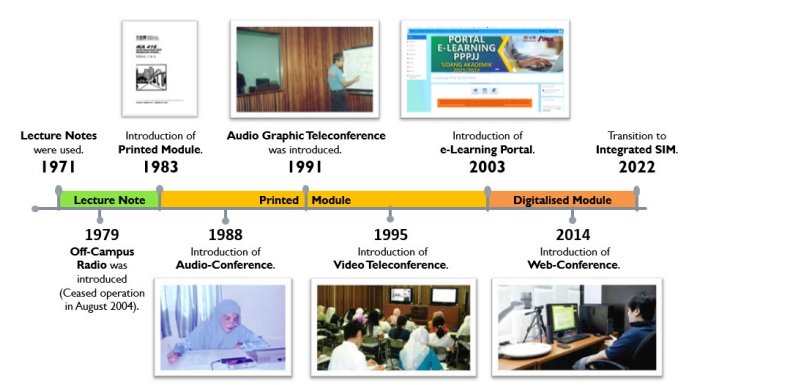
You’ve just explored the rich history of SDE in previous section, witnessing its long journey from conventional teaching methods to the latest, cutting-edge approaches in distance education. This evolution underscores SDE's unwavering dedication to providing top-quality education to its distance learners.
The advancement of technology has been a game-changer in this journey, allowing SDE to continuously improve and innovate, ensuring that distance learning is not only accessible but also engaging while enabling students to learn at their own pace since 1971 until now. Let's explore how technology has transformed SDE from traditional methods to modern e-learning.
1971
Initially, SDE started with conventional face-to-face teaching methods, relying heavily on lecture notes to deliver course content to students.
1979
SDE took a significant step forward by introducing off-campus radio broadcasts. These broadcasts allowed students to access lectures remotely, making learning more accessible.
1983
Printed modules was used as a learning material for the students. Some of modules will deliver to the distance learners using postage.
1988
Initially, Audio-Conference was introduced around 1988.
1991
SDE took a significant step forward by introducing off-campus radio broadcasts. These broadcasts allowed students to access lectures remotely, making learning more accessible.
1995
Video teleconference was introduced. This innovation has significantly transformed the landscape of distance education, making it more accessible and effective.
2003
SDE has created an e-learning portal to enhance the learning experience for its students. This portal serves as a centralized hub where learners can access a variety of educational resources.
2014
The introduction of web conferencing marked the beginning of the digitalization era for SDE. This innovative technology transformed how teaching is delivered and enabling real-time communication between instructors and students.
2022-now
SDE transitioned to an integrated Self-Instructional Material (SIM) approach, marking a significant advancement in its educational delivery. The PEARL portal became a central hub for learning, providing students with access to SIM content.

You have learned about ODL and SDE digitalisation from the section above. You might also wonder how Learning Management Systems (LMS) relates with ODL, right? Well, LMS are integral to the effective implementation of Open and Distance Learning (ODL). They provide a digital platform for interaction between students and educators, facilitating various academic activities and announcements through online platform.
In SDE context, distance education is a mode of learning where students and instructors are physically separated, and instruction is delivered entirely online by using Self-Instructional Material (SIM). Interaction occurs through online platforms such as using Learning Management Systems (LMS), emails, video conferences (Cisco Webex), educational application tools and social media as a medium for discussions.
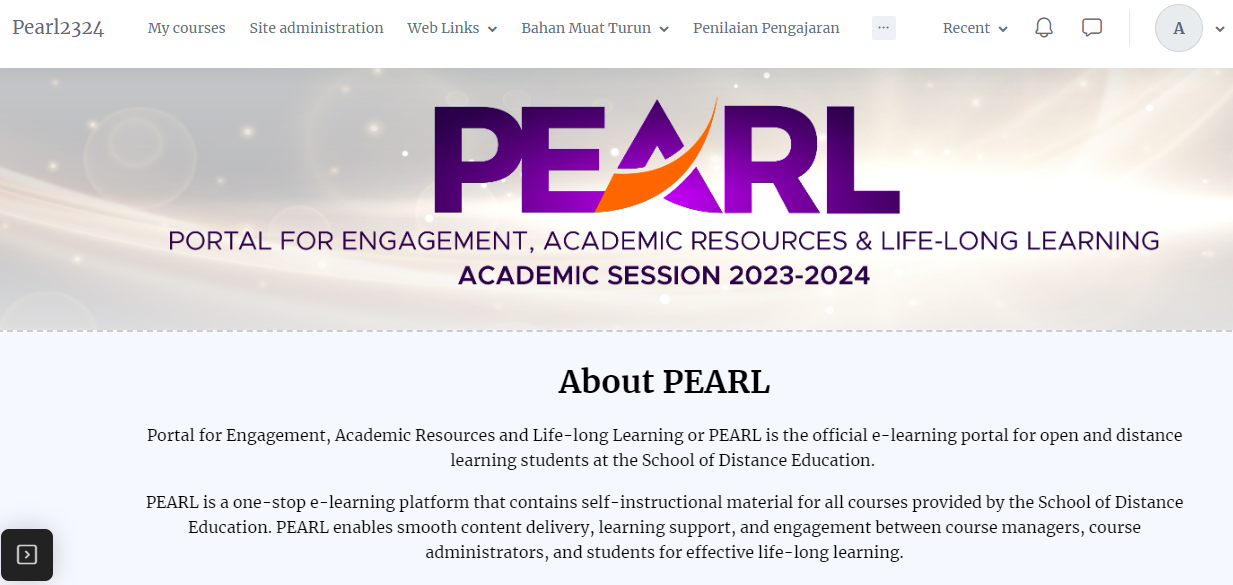
PEARL, the portal used by the School of Distance Education at Universiti Sains Malaysia, is built on this Moodle foundation. As a one-stop e-learning platform, PEARL serves as the central hub for distance learners, offering a comprehensive suite of resources and tools to support their studies. The portal includes self-instructional materials (SIM), which are specifically designed to guide students through their learning journey independently. These materials are integrated within the Moodle framework, enabling seamless access to learning content, activities, and assessments.

The portal's integration with Moodle ensures that it benefits from Moodle's robust features, such as detailed reporting, scalability, and the ability to support various multimedia formats, enhancing the overall learning experience for distance learners.
Open Distance Learning (ODL) at the School of Distance Education (SDE), Universiti Sains Malaysia, is a well-structured system that combines several key components in order to deliver effective and engaging distance education. It operates through the integration of a robust teaching model, Self-Instructional Materials (SIM), and instructional design principles.
Self-Instructional Material or SIM are developed well by course managers in order to provide self-learning among the students. All the courses was delivered by using learning management system (LMS) in PEARL portal (please refer to previous section about the portal.
Online classes conducted via Webex are held synchronously for 1 hour. Each session is recorded, allowing students to watch them again later through the Webex Tab on PEARL. This setup ensures that students who cannot attend the live session still have access to the content.
An intensive course involves face-to-face classes designed to enhance student engagement with course managers. During this time, students can ask questions, seek explanations, participate in lab work, attend seminars, give presentations, and take continuous examinations. The intensive course also provides an opportunity for School of Distance Education (SDE) students to experience university life, as they typically study online through the portal.
Multiple Mode AfL
Instructors also requires to provide multiple mode of assessment for learning. For example for coursework typically includes various forms of assessment such as assignments, presentations, and reports, which allow students to demonstrate their understanding of the material throughout the course. Students are also required to take a final examination, which is conducted synchronously or face-to-face. This final exam serves as a comprehensive evaluation of the students' grasp of the entire course content, providing a balanced approach to assessing both their continuous effort and overall learning outcomes.
SDE offers a range of resources and support services to ensure a comprehensive learning experience for distance learners. Students are able to access the USM Library online to find collection of digital resources, including e-books, journals, and research databases from anywhere. Moreover, various student activities are organized by our school to foster a sense of community and engagement among learners, even though they are studying remotely.
Administrative support is also available in both synchronous and asynchronous formats, ensuring that students can receive help with course registration, technical issues, and other administrative tasks at their convenience. Together, these services are designed to create a rich and supportive educational environment, mirroring the resources and experiences typically available to on-campus students, but tailored to meet the needs of those studying from a distance 😃
Course Registration
Online course registration via Campus Online.
Self-learning & Online Classes
Self-learning using SIM on PEARL.
• Attending online classes via Webex
• Prepare coursework
Intensive Course
Students will attend tutorial, lab, joining field trip, presentation, seminar, get a consultation from course managers and sit for Continuous Examination
Self-learning & Online Classes
Students continue their self-paced learning in SIM on PEARL portal, attending webex classes and preparing for the coursework
Self-learning & Online Classes
Students will Sit for Final Exam in selected locations and will conduct in face to face.

SIMs, or Self-Instructional Materials, are specially designed to help our students learn on their own. They include course content, learning activities, and self-assessments, all aimed at guiding the distance learners to reach the learning objectives without needing an course instructor right there with them.
Think of it like a user manual or those lego assembly instructions—they're great examples of SIMs. Just like how you can put together all the lego parts without needing others help, SIM will guide your students through learning journey independently.
COPPA: ODL is a document that is intended to provide guidelines for Higher Education Providers (HEPs) offering programs through Open and Distance Learning (ODL) for accreditation and program audit purposes.HEPs planning to offer ODL programs must strictly adhere to the standards outlined in COPPA, as well as relevant program standards where applicable. In disciplines where specific program standards exist, those requirements will take precedence. You can read about the document at references on this topic.
Based on Glossary No. 64:
An educational material that facilitate personalized learning. SIM is developed based on sound instructional design principles (namely it should be learner-friendly, written in conversational writing style and use simple language, include learning activities, self- assessment and feedback).
The material may be in various forms; print-based, web-based, multimedia, interactive book etc. Study guide can be an integral part of SIM.
Area 1.2.5 (iv):
SIM for the ODL programme must be
provided in the following ways: adopting existing
materials; adapting existing materials; or creating
original materials; or any other appropriate
approaches
Assessment activities for ODL (Open and Distance Learning) students should apply the various learning technologies available to enhance the effectiveness and achieve the learning outcomes. These technologies include online quizzes, interactive tasks, discussion or forums that can be integrated into learning management systems like Moodle.
It is crucial that an appropriate assessment method and mechanism is in place. Assessment activities should leverage on the functionality and availability of learning technologies. The methods of student assessment must be clear, consistent, effective, reliable and in line with current practices. They must clearly measure the achievement of the intended learning outcomes.
The main goal of developing Self-Instructional Material (SIM) is to support adult learners in reaching their intended learning outcomes and overcoming any challenges they might face. This is done by:
✅Presenting the course content in a clear and organized way
✅Breaking down the content into smaller, manageable chunks
✅Offering guidance and motivation to encourage independent learning.
✅Including learning activities that help reinforce knowledge through practical application.
✅Providing feedback opportunities so students can assess their understanding, see where they got things right, or identify any mistakes.
How these Instructional Design Principles relate to ODL and why instructors need to know?
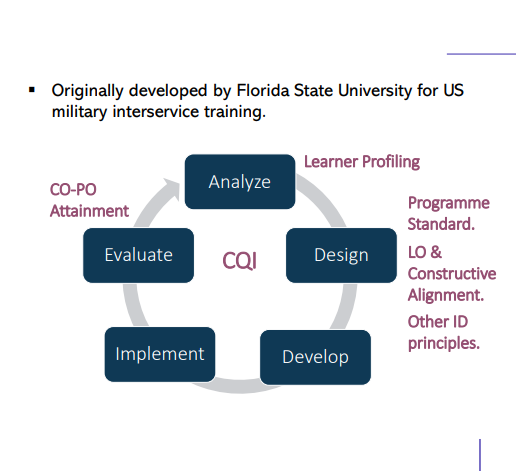
The ADDIE model is a framework for instructional design that includes five phases: Analysis, Design, Development, Implementation, and Evaluation. In the context of ODL, this model ensures a structured approach to creating courses that are well-organized and learner-centered. The flexibility of the ADDIE model makes it particularly suitable for designing distance learning materials, as it allows for continuous improvement based on learner feedback. It will guide instructors through the entire process, from identifying learner needs to evaluating the success of the Self-Instructional Material.
Bloom's Taxonomy provides a hierarchical classification of cognitive skills, from basic knowledge recall to higher-order thinking skills like analysis and evaluation. In ODL, where learners often study independently, it’s crucial to design activities and assessments that cater to different levels of cognitive processing. This ensures that learners not only absorb information but also apply, analyze, and create based on what they’ve learned. Instructors need to be familiar with Bloom’s Taxonomy in order to craft learning outcomes for activities and assessments that align in SIM.
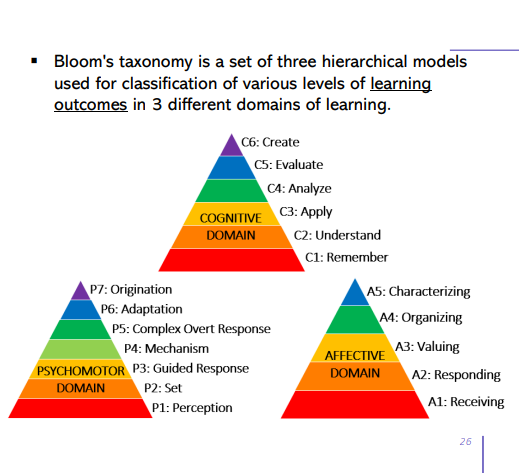

Biggs suggested that the verbs in intended learning outcomes (ILO) becomes the common link that establishes alignment between the ILO between, the teaching/ learning activities, and the assessment tasks. For example, an instructor is teaching about psychology and his learning outcomes is "Apply expectancy - value theory to address a classroom management issue effectively"
Alignment - is based on the psychology of constructivism
Alignment - both teaching and assessment need to be aligned to the intended learning outcomes
Learning Activity
Case study based on situation based in the classroom
Assessment
Create a rubric to assess students’ proposed solutions for classroom management issue
Modular instruction is a different approach to instructional design that utilizes tailored educational materials that cater to students' needs. An instructional module is self-contained, self-pacing and self-learning technique of instruction. This method encourages students to engage in a variety of interesting and challenging activities to help sustain their focus and attention, promoting independent learning.
Self-Contained Units: Each module is designed as an independent unit of learning that covers specific learning outcomes. Learners can engage with the content on their own without immediate instructor intervention.
Sequential or Non-Sequential Learning: Modules may be designed to be completed in a specific order (sequential) or allow flexibility where learners can choose the order based on their preferences or learning needs (non-sequential).
